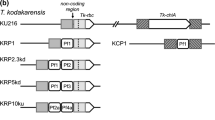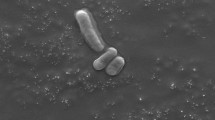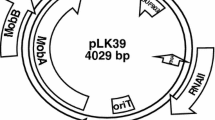Summary
A fragment of DNA which functions as an autonomous replication sequence in yeast was cloned from Cephalosporium acremonium. Mitochondrial DNA (mtDNA) was isolated from an industrial strain of C. acremonium (08G-250-21) highly developed for the production of the antibiotic, cephalosporin C. Size, 27 kb, and restriction pattern indicated this DNA was identical to mtDNA previously isolated (Minuth et al. 1982) from an ancestral strain (ATTC 14553) which produces very low amounts of cephalosporin C. A 1.9 kb Pst1 fragment of the Cephalosporium mtDNA was inserted into a Pst1 site of the yeast integrative plasmid, Ylp5, to produce a 7.5 kb plasmid, designated pPS1. The structure of pPS1 was verified by restriction analysis and hybridization.
PS1 transformed Saccharomyces cerevisiae (DBY-746) to uracil prototrophy at a frequency of 272 transformants/μg DNA. Transformation frequencies of 715 transformants/μg DNA and zero were obtained for the replicative plasmid, YRp7, and the integrative plasmid YIp5, respectively. Southern hybridization and transformation of E. coli by DNA from yeast transformed by pPS1 verified that pPS1 replicates autonomously in yeast.
The uracil-independent pPS1-yeast transformants were mitotically unstable. The average retention of pPS1 after three days growth in selective and non-selective medium was 4.5% and 0.4%, respectively, compared to retentions of 4.6% and 0.5% for YRp7. The properties of pPS1 were compared to those of a related plasmid, pCP2. pCP2 was constructed (Tudzynski et al. 1982) by inserting the C. acremonium 1.9 kb Pst1 fragment into the yeast integrative plasmid, pDAM1.
Similar content being viewed by others
References
Beach D, Piper M, Shall S (1980) Nature (Lon) 284:185–187
Beggs JD (1978) Nature 275:104–109
Boyko WL, Ganschow RE (1982) Anal Biochem 122:85–88
Clewell DB (1972) J Bacteriol 110:667–676
Cohen SN, Chang ACY, Hsu L (1972) Proc Natl Acad Sci USA 69:2110–2114
Elander EP, Aoki H (1982) In: Morin RB, Gorman G (eds) β-lactam-producing microorganisms: their biology and fermentation behavior. Chemistry and biology of β-lactam antibiotics. Academic Press, New York, pp 83–153
Gorman JA, Dove WIT, Warren N (1981) Mol Gen Genet 183:306–313
Hsiao C, Carbon J (1981) Gene 15:157–166
Hudson B, Dawson JH, Desiderio R, Mosher CW (1977) Nucleic Acids Res 4:1349–1359
Hyman BC, Cramer JH, Rownd RH (1982) Proc Natl Acad Sci USA 79:1578–1582
Kiss, GB, Amin AA, Pearlman RE (1981) Mol Cell Biol 1:535–543
Klein RD, Selsing E, Wells RD (1980) Plasmid 3:88–91
Maniatas T, Fritsch EF, Sambrook J (1982) In: Molecular Cloning. Cold Spring Harbor Laboratories, New York, pp 104–106
Meselson M, Yuan R (1968) Nature 217:1110–1114
Minuth W, Tudzynski P, Esser K (1982) Curr Genet 5:227–231
Miller JH (1972) In: Experiments in Molecular Genetics. Cold Spring Harbor Laboratories, New York, pp 431–433
Queener SW, Neuss N (1982) In: Morin RB, Gorman G (eds) The biosynthesis of β-lactam antibiotics. Chemistry and Biology of β-lactam Antibiotics. Academic Press, New York, pp 1–81
Rigby PWJ, Dieckmann M, Rhodes C, Berg P (1977) J Mol Biol 113:237–251
Southern EM (1975) J Mol Biol 98:503–517
Stinchcomb DT, Struhl K, Davis RW (1979) Nature 282:39–43
Stinchcomb DT, Thomas M, Kelly J, Selker E, Davis RW (1980) Proc Natl Acad Sci USA 77:4559–4563
Struhl K, Stinchcomb DT, Scherer S, Davis RW (1979) Proc Natl Acad Sci 76:1035–1039
Tickhomirova LP, Kryukov NI, Strizhov NI, Bayev AA (1983) Mol Gen Genet 189:479–484
Tudzynski P, Esser K (1982) Curr Genet 6:153–158
Tudzynski P, Esser K (1983) Curr Genet 7:165–166
Wahl GM, Stern M, Stark GR (1979) Proc Natl Acad Sci USA. 76:3683–3687
Zakian VA (1981) Proc Natl Acad Sci USA 78:3128–3132
Zakian VA, Kupfer DM (1982) Plasmid 8:15–28
Zakian VA, Scott JF (1982) Mol Cell Biol 2:221–232
Author information
Authors and Affiliations
Rights and permissions
About this article
Cite this article
Skatrud, P.L., Queener, S.W. Cloning of a DNA fragment from Cephalosporium acremonium which functions as an autonomous replication sequence in yeast. Curr Genet 8, 155–163 (1984). https://doi.org/10.1007/BF00417811
Received:
Issue Date:
DOI: https://doi.org/10.1007/BF00417811




